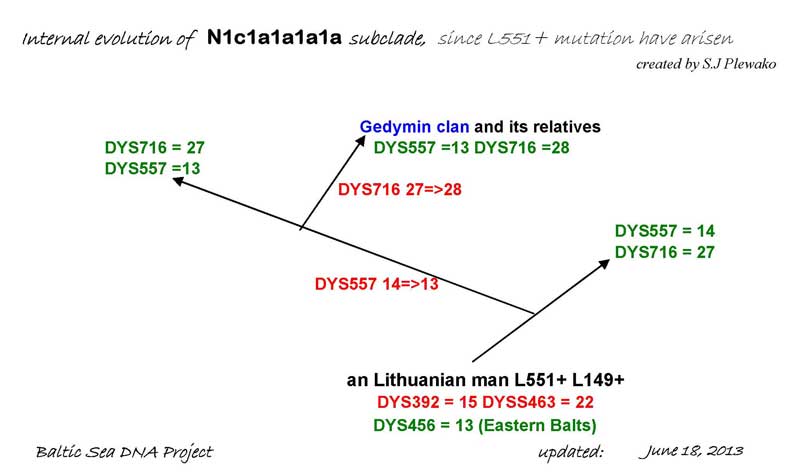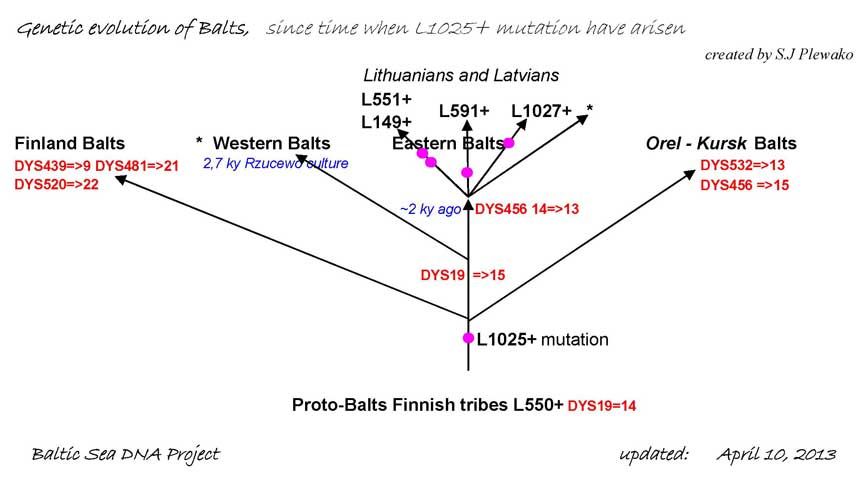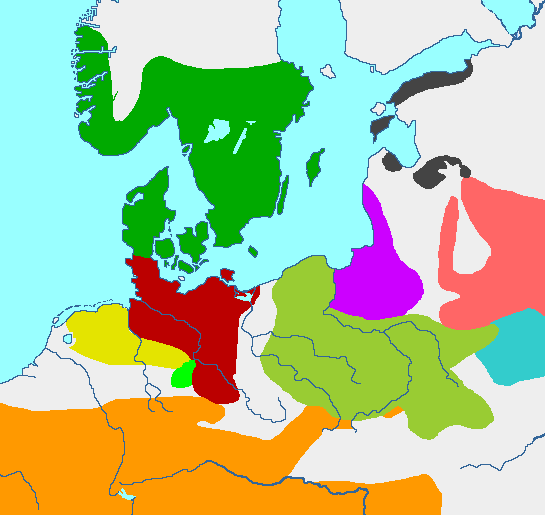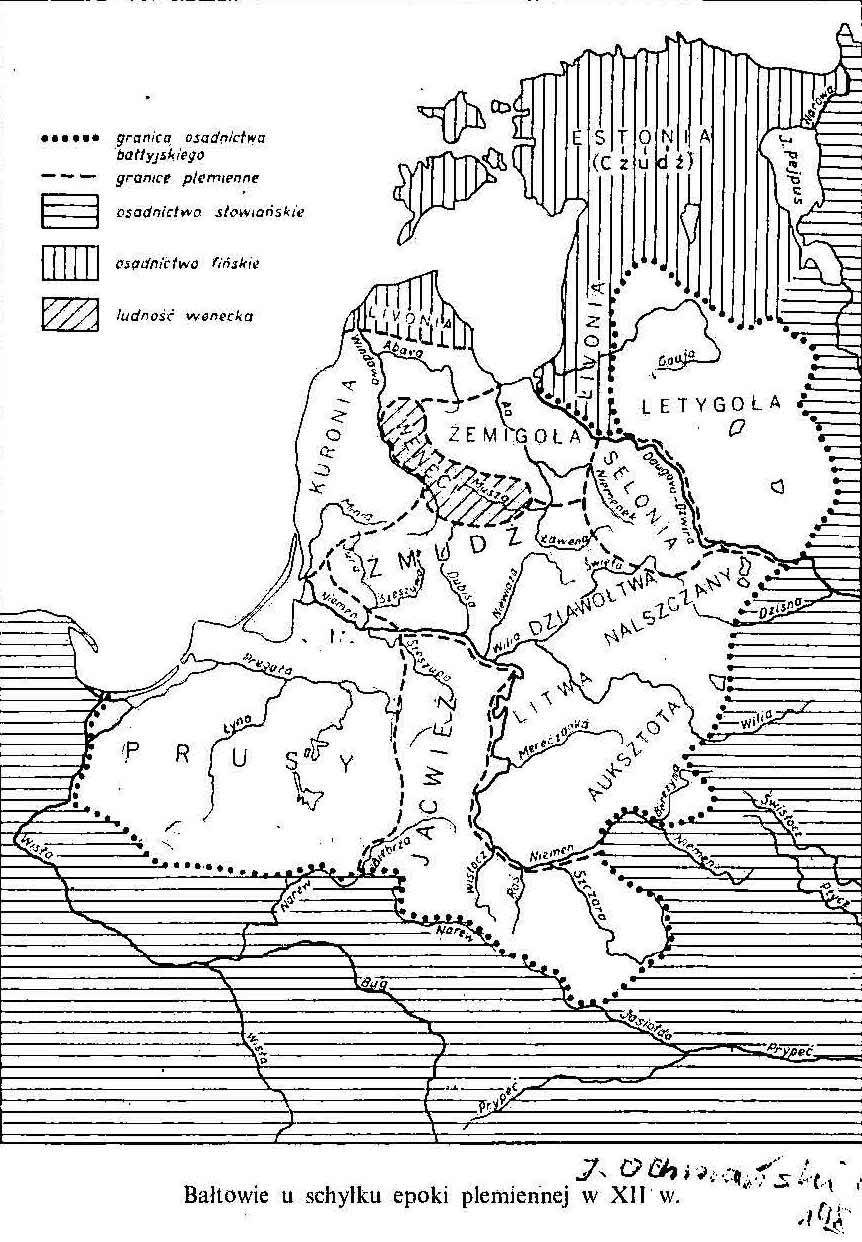About us
SNP position see: Human Y Chromosome ISOGG Browser
Below Provisional classification for N-L1025 derivatives
and a sister branch N-Y4339
The N-Y4339 branch represents the legendary Varangian Prince Rurik and his clan who founded the Rurik Dynasty which ruled Kievan Rus (and later the Grand Duchy of Moscow and Tsardom of Russia) until the 17th century
(possible affiliation to Lithuanian tribes added,
see a prof. Ochmański map, below)
Balts at the end of the tribal era in XII century,
according prof. Ochmański J., 1982, "historia Litwy"
publ.: 2014-07-18
Internal STR evolution of L551+ L1025+Terminal Subclade

In my opinion the DYS557 mutation 14=>13 was the first step in splitting the subclade and thus making it a very important marker.
In the earlier work of Vladimir Volkov (2012, Nov.) this marker was not used in his calculations.
SNP L1025+ isolate from N-L550+ sub-branch characteristic for the Balts descendants
A mutation L1025+ discovered in February 2012 in FT DNA WTY Program participant distinguishes Baltic Tribes descendants from other representatives of the N-L550+ branch. This conclusion applies not only to the modern Balts: Lithuanians and Latvians - but also to the descendants of extinct tribes West Balts: Prussians, Curonians, Yotvingians, and even to the majority of this inhabitants of the modern Belarus, which belongs to N1C1 haplogroup. This is a present look for genetic evolution of Balts:

Picture on the link (created by S. Melnyk) show structure of N-L1025 subclade as we see it in May 2014: http://www.stanislaw.plewako.pl/DNA/L1025_small.jpg
Stanislaw Plewako
publ.: 2014-05-10SNP S17250 divide I-L621 L147.2 (CTS5966) Dinarics subclade
In 2014 results of BigY Survey Program give us a new portion of knowledge about a big and not structured up till now part of Slavic languages people I-L621 L147.2 CTS5966+ which are a remains of Venedi Peoples from Roman Empire period (see the location of the Venedi in the upper Vistula region and south of Polesian Lowland in times of the Roman empire under Hadrian (ruled 117-138), source http://en.wikipedia.org/wiki/Vistula_Veneti (see map below)
The current state of knowledge about the diversity within the group I-L621 L147.2 CTS5966+ is shown in ISOGG phylotree: http://www.isogg.org/tree/ISOGG_HapgrpI.html
It is divided between two or tree subclades: S17250 - majority of tested, and Y4460 possible a remnant of the Baltic Veneti, and maybe Z17855
Lack of geographical separation of Venedes caused mixed population and we are not able to predict on STR basis real SNP subclades.
But only inside of those subclades an STR analysis is valuable. So it is strong recommendation for testing, S17250 at first.
(choose Order An Upgrade, Order an Advanced Test, SNP, S17250).
The best choice is to test in BigY Program, but it is about 10 times more expensive than simply two SNP tests. In table of results we can compare results with those members of BigY Program: #213694, #76814, #256403, #280968, #310872, #145940, #N117657, #131251, #156366, #209633, #N18656, #359901, #317737, #109223, #B9938, #208340,
Stanislaw Plewako
publ.:2014-11-29
modif.: 2019-11-28
Map of the Baltic tribal cultures and others archaeological cultures V-VII centuries, Koryakov
http://pl.wikipedia.org/wiki/Plik:East_europe_5-6cc.png
On the map: ВЕНЕДЫ = Vistula Veneti. I have identify those peoples as I2a-L621 haplogroup holders, of course in this era - with Slavic languages.

Please refer also ”Пражско-корчакская арxеологицеская культура ВЕНЕДЫ 5-7 в.” on the second map (Востоцная Европа в V-VІ вв. н.э)
on https://www.familytreedna.com/public/balticSea/
Archeological cultures in Central Europe at the early pre-Roman Iron Age (700-100 BC)
violet - west-Baltic culture of cairns/earlier Rzucewo culture; light red - East-Baltic culture of forest zone;
green - Pomeranian culture; turquoise - Milograd culture (Neures?);

source: Wikipedia Commons, ossipro,
scientific source: H. Beck, H. Steuer, D. Timpe (ed.): Reallexikon der Germanischen Altertumskunde.
Die Germanen, 1998, de Gruyter, Berlin New York, p. 144, ISBN: 3-11-016383-7

